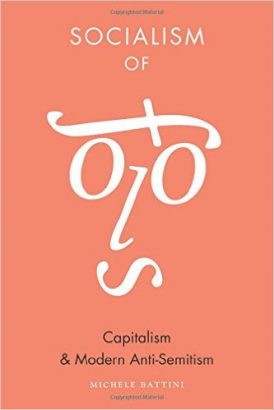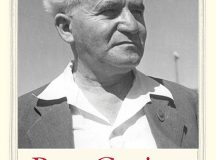The Italian academic, Michele Battini examines the gradual transformation of the traditional Christian anti-Semitic charge of usury into modern anti-Jewish anti-capitalism. Fuelled by the economic transformation in the nineteenth century and the self-regulated market, anti-Jewish anti-capitalism emerged from the anti-Judaic foundations laid by John Chrysostom, St. Jerome and St. Ambrose in the fourth century. In this important book, Battini compares this transformation to ‘the slow processes of hereditary biology’.
Battini argues while the European Enlightenment with their interlocutors, the philosophes, facilitated the Declaration of the Rights of Man and the Citizen in France, it also removed the centuries-old barrier between Jewish communities and the Christian societies in which they lived. Above all it removed control over the commercial and financial workings of the Jewish communities from the Bourbon monarchy – which Louis XVI and his ancestors had exploited to maintain their courts, pay for their wars and build their edifices to self-grandeur. The counter-revolutionary answer to this breaking of the chains was to identify Jewish financiers with the new capitalism in the 1790s and to make the Jews scapegoats for financial speculation. In essence to update the stereotype of medieval Jewish usury to a modern anti-Jewish anti-capitalist one.
Battini determines the historical fault line to be the storming of the Bastille in 1789, the beginning of the French Revolution which upset the ‘natural’ order of things and liberated the Jews from their ghettos. Louis de Bonald, an émigré in exile, published a book in 1796 that challenged revolutionary constitutionalism and connected his thesis to theological-political ideas. On his return to France, Bonald wrote Sur les juifs which Battini regards as the first text relating an attack on democracy and equal rights with ‘an explicit anti-Jewish anti-capitalism’. The French Constituent Assembly, Bonald suggested, had made the grievous error of knowingly enacting laws which conflicted with religion and customs. This approach would be inherited and modified by social Catholic writers and some socialist polemicists throughout the nineteenth century.
Battini asserts that Bonald’s views were aided by a Catholic Church anxious to reverse the tide of French revolutionary thought after the defeat of Napoleon at Waterloo in 1815 – and traces a direct line of complicité through the years to Franco’s Spain and Vichy France in the twentieth century. The ideological writings and fascist politics of Charles Maurras, the architect of fin-de-siècle anti-Semitism, covered the period from the Dreyfus affair to World War II. For Maurras, the establishment of the Vichy regime represented the opportunity to reverse ‘the disruption of 1789’. Maurras was sentenced to life imprisonment at the war’s end.
Catholicism saw itself as the only true religion, bolstered by centuries of accumulated wisdom. It provided stability for society based on hierarchical tradition and values. In addition to being deicides, the dissident nature of the Jews, their stubbornness, their stiff-neckedness, – and perhaps, most pertinently, their unwillingness to renounce the free market – threatened such a structure.
In 1845 Alphonse Toussenel published his Les juifs, rois de l’époque and commented that:
Protestants and Jews, thanks to emancipation after 1787 and 1791, have controlled public opinion in order to favour trafficking and rigging the market, blocked every defence of royalty and of the people, put the producer and the consumer at their mercy so that in France the Jew reigns and governs.
Toussenel was also the first to make a proposal for a socialised economy based on the expropriation of ‘Jewish capital’. Catholic views on Jews finally reached nationalist parties and movements at the end of the nineteenth century. Karl Lueger who was elected the mayor of Vienna in 1895 resurrected Toussenel’s views on expropriation – and Lueger’s anti-Semitism was regarded as a paradigm by Hitler and the Nazis.
The broad movement of this new anti-Semitism in the late nineteenth century provided the Catholic Church with the base to mount a further assault on civil rights and the growing secularisation of society. Jews were being transformed into ‘a hostile power within the national Christian community’. The Church took up the leadership of anti-rational movements. 500 anti-Jewish works were published between 1873 and 1890.
By the end of the century, economic depression and general political corruption in France were being laid at the feet of the Jews. They were blamed for the collapse of the Union Genéralé, a major Catholic bank. This political environment led directly to the Dreyfus trial – and the depiction of its defendant as symbolic of the Jewish malaise afflicting France. Jews were turned into a sinister emblem of capitalist modernisation.
Anti-Jewish anti-capitalism diffused into tributaries, characterised by thinkers such as Maurice Barrès (populist), August Chirac (socialist), Edouard Drumont (Catholic nationalist) and Paolo Orano (revolutionary syndicalist).
August Bebel is remembered today for his incisive comment in 1894 that anti-Semitism was ‘the socialism of fools’. But who were the fools? They were no doubt the utopian socialist Fourier, the anarchist Proudhon, and their followers. George Duchene, a student of Proudhon, wrote in approval of a pogrom in Tsarist Russia in 1869. He explained that it was merely a reaction by honest people against the Jews – ‘parasites, usurers, exploiters of the people’.
Battini’s book concentrates on the life and times of another of Proudhon’s followers, the Italian Paolo Orano, originally a revolutionary syndicalist anti-capitalist. By 1881, the Jesuit La Cività Cattolica had enacted a campaign which exploited the new anti-Semitism. Studying under Antonio Labriola and friendly with Enrico Ferri – both incidentally Jabotinsky’s teachers during his time in Rome as a student – Orano joined the editorial staff of Avanti, the organ of the Italian Socialist Party. He also began to write for a weekly revolutionary syndicalist periodical, La Lupa, in which he attacked the reformists within the socialist party. He further accused the Jews of reducing the party to one where the bourgeoisie felt at home. He wrote about ‘a Jewish imperialism’, ‘a Judaic Orient’ and ‘a Latin Judaism’ which was infecting Italy.
Orano argued that freemasonry with its integrated Jewishness planned to take over Italy and eliminate ‘the least sign, spirit and form of Catholicism’. His targets were the three Jewish leaders of Italian socialism: Luigi Luzzatti (prime minister), Ernesto Nathan (mayor of Rome) and Claudio Treves (Editor of Il Tempo).
Orano transformed revolutionary syndicalism into a national syndicalism which became one of the central components of Italian fascism. Mussolini subsequently acknowledged his ideological debt to Paolo Orano.
Orano also integrated into Italian fascism the logic of anti-Jewish anti-capitalism. But as the author points out, Orano was one of the first to attach this paradigm to the radical polemic against Zionism. Orano argued that Italian Jewish support for Zionism compromised Italy’s strategic position in the Mediterranean – and thereby aided its rival, Great Britain. It sought to undermine Italy’s desire to maintain a presence in the Arab world.
Up until the alignment with Nazi Germany in 1937, Italy had not persecuted its Jews in a major way. Battini believed that Orano’s writings at this time helped to move Mussolini from an anti-Zionist position to an anti-Semitic one. It assisted in underpinning the alliance with Germany.
Opposition to Jews per se now became the cement which bound the Italian nation together. Jews were outside this holy of holies. The Racial Manifesto which was published in July 1938 stated:
There is by now a pure “Italian race”. This statement is not based on the mixing up of the biological concept of race with the historical-linguistic concept of a people and a nation, but on the purest blood ties that unite the Italians today with the generations that for millennia have populated Italy. This ancient purity of blood is the greatest claim to nobility of the Italian nation.
In the final chapter, the author notes that although Pope Pius XI condemned Nazi racist mythologies, there was no explicit mention of anti-Semitism. Nor was there any response to the demand for a statement of condemnation r from either Konrad von Preysing, the Bishop of Berlin or from Andrzej Szeptycki, Greek Catholic metropolitan Bishop of Lvov. Moreover, the Church in Poland did not wish to acknowledge that the mass killing of Jews in Jedwabne in 1941 had been carried by their Polish neighbours.
This academic work by Michele Battini demands the full attention of its reader. Every sentence counts and the reader is rewarded by astute insights and detailed explanations. It is an important and highly interesting book which has been well-researched. Battini’s warning from history is still pertinent in 2016: ‘The enemy has not stopped winning – as Walter Benjamin has written – and while he continues to win, not even the dead will be safe.’





































This is a very timely study. Looking forward to read it, Thanks
Thanks. Looking forward to reading this, it sounds fascinating.
Another book entitled The Socialism of Fools, Anti-Semitism on the Left by Michael Lerner was published by Tikkun Books in 1992. This is the same Michael Lerner imprisoned along with Mohammad Ali and others in the sixties and described by J. Edgar Hoover as ‘one of the most dangerous criminals in America’. Now as Rabbi Michael Lerner, editor of Tikkun Magazine he is involved in controversy regarding the US elections. He received several standing ovations at Mohammad Ali’s memorial service – see YouTube. He shocked many by referring to the future president as ‘she’. While Bill Clinton was President, he and Hillary had been avid readers of Tikkun. I don’t want to bore you with the details as I’m sure you know the what happened in the aftermath.
His book The Socialism of Fools, includes comments on How Anti-Semitism functions in Liberal and Progressive Organisations, The Failure of the New Left to grasp the Dynamics of Anti-Semitism, The Zionism-is-Racism Slander, Jewish reactions to Jew Hating in the 20th Century, etc,
I imagine you’ve read it and I’d love to know your opinion on it’s current relevance.